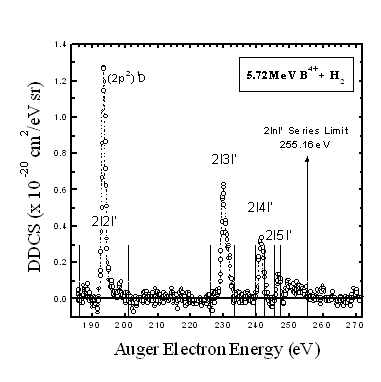PRODUCTION OF DOUBLY EXCITED STATES IN HE-LIKE BORON
E.P. Benis1,2, T.J.M. Zouros1,2 and P. Richard2
1University of Crete, Department of Physics, Heraklion, Crete, Greece
2Kansas State University, J.R. Macdonald Laboratory, Manhattan, KS 66506, US
We report
on the production of doubly excited ionic states in two-electron Boron ions (B3+)
for collisions of 5.72 MeV B4+ on H2. Doubly excited
states are populated primarily via the
resonance transfer and excitation process (RTE)1. The experimental
signature of the production of doubly excited ionic projectile states is the
detection of the electrons resulting from the Auger decay of such states.
The ionic beam was produced in the KSU Tandem
Van de Graaff accelerator. B4+ ions were obtained by post-stripping
the primary B3+ beam at a carbon foil target before colliding it
with the H2 target. The beam energy was chosen so that the electron
energies are detected at the binary encounter peak region, so that the data can
be normalized with respect to the binary encounter yield. The spectra were
measured with the new paracentric hemispherical spectrograph2. The
data were recorded in four different energy slices, matched in the overlapping
regions and normalized to the binary encounter peak after being corrected for
dispersion.
The spectra, plotted in
the projectile rest frame, are shown in fig. 1. The formation of the
(2p2)1D
line is seen to be the most prominent. Although the conventional single
configuration scheme can be safely applied for the 2l2lí lines, the admixture
of many configurations is substantial for the 2lnlí (n≥3)
states. Therefore,
the aformentioned notation 2lnlí,
retained in fig. 1, should only be taken as a convenience, since there is still
a one-to-one correspondence between the radial quantum numbers (2 and n) and
the true states3.
Following Lipskyís
calculations3 for the doubly excited states in isoelectronic helium
below the n = 2 threshold, the Auger electron energies resulting from the decay
of B3+(2lnlí) doubly excited states to the ground state B4+(1s),
were obtained. In fig. 1, the results for the energy limits of each
isoelectronic sequence are noted. Although the experimental energy resolution
was not adequate for resolving the 2lnlí (n≥3)
states, the experimental data are seen to be in excellent agreement with the
calculations.
Figures:

Figure 1:
Experimental data for collisions of 5.72 MeV B4+ with an H2 target.
Isoelectronic sequences of doubly excited states of He-like Boron formed by
RTE and de-exciting via Auger decay are seen to be in excellent agreement to
the theory (solid lines). A dashed line connecting the experimental points is
drawn to guide the eye. DDCS are accompanied by an average statistical error
bar of 0.5x10-20 cm2/eV sr.
References:
1) T.J.M. Zouros, in Recombination of Atomic Ions, Vol. 296 of NATO Advanced
Study Institute Series B: Physics, edited by W.G. Graham, W. Fritch, Y Hahn and
J. Tanis (Plenum, New York, 1992), pp. 271-300.
2) E.P. Benis et al., Nucl. Instr. Meth. in Phys. Res. B 146, 120-5 (1998).
3) L. Lipsky, R. Anania and M.J. Conneely, Atomic Data and Nuclear Data Tables 20, 127-141 (1977).
This work was supported by the
Chemical Sciences, Geosciences and Biosciences Division,
Office of Basic Energy Sciences,
Office of Science,
U.S. Department of Energy.
Submitted to ICPEAC 2001, July 2001 in Santa Fe, NM.
This abstract is also available in
Postscript or
Adobe Acrobat formats.
